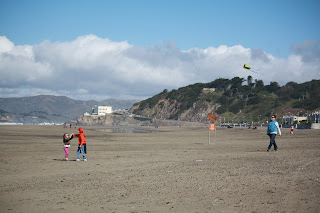My kids and I are in San Francisco, CA for a special family event this week, so we've had lots of wonderful family time. Sunday, we also had some wonderful nature time. After three days of rain, Sunday brought bright warm, sunshine, so we walked down to Ocean Beach. This was completely unstructured time. To start, my kids did what any kid would do... race the waves and risk getting their feet wet. They also collected rocks and shells, wrote their names in the sand, and flew a small pocket kite. When my daughter first wanted to purchase a pocket kite at the Air and Space Museum in Washington, DC I was skeptical that it would fly. But we took it to the National Mall and found it worked as well as any other kite we had flown. Both of my kids now have one and they have been terrific for times like Saturday. All you need is a little open space, a small breeze, and some energetic kids.
In addition to the usual beach glass, seashells, and sand dollars we found on ocean beach, my sister found a fossil. You really cannot predict what you might discover when you pay attention in nature. We think it's a piece of a sand dollar. What do you think?
You don't need to spend lots of money or plan elaborate outings to enjoy nature, spend time with your kids or students, and create lasting memories. All you need is a willingness to get outside with them. One other great benefit: After getting so much exercise, my kids slept like logs.
In addition to the usual beach glass, seashells, and sand dollars we found on ocean beach, my sister found a fossil. You really cannot predict what you might discover when you pay attention in nature. We think it's a piece of a sand dollar. What do you think?
 |
| Sand dollar plus a fossil- possibly from a sand dollar |
One San Francisco mom I spoke to on Sunday told me she finds the beach the place she can best expose her kids to the wildness of nature. For my readers who live in the city, how do you keep nature in your kids' lives? What are your favorite places?







